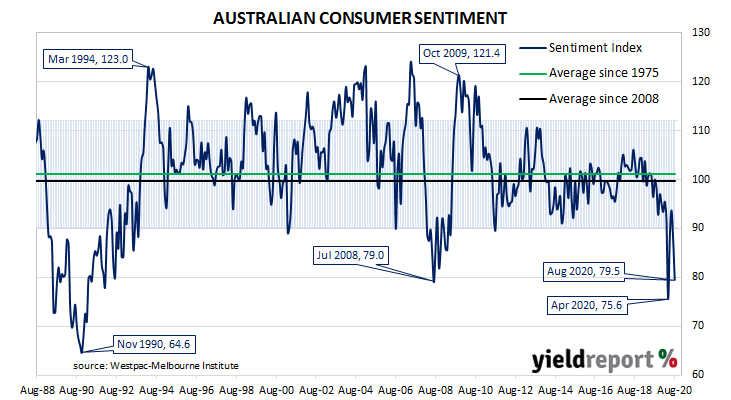Summary: Household sentiment retreats for second consecutive month; confidence index back to level comparable to April; extent of deterioration in non-Victorian states a surprise; index significantly below long-term average; Westpac chief economist says August reading be treated cautiously; households “extremely worried” about job loss.
After a lengthy divergence between measures of consumer sentiment and business confidence in Australia which began in 2014, confidence readings of the two sectors converged again around July 2018. Both readings then deteriorated gradually in trend terms, with consumer confidence leading the way. Household sentiment fell off a cliff in April but then staged a recovery through May and June. Recent readings have reversed much of that.
According to the latest Westpac-Melbourne Institute survey conducted in early August, average household sentiment has continued to falter. The Consumer Sentiment Index declined from 87.9 to 79.5, taking it back to a level not far above April’s cyclical low of 75.6.
“The scale of the fall comes as a major surprise,” said Westpac chief economist Bill Evans.
Local Treasury bond yields increased noticeably at the long end, largely in line with higher US Treasury yields in overnight trading. By the end of the day, the 3-year ACGB yield had added 1bp to 0.31%, the 10-year yield had gained 5bps to 0.94% while the 20-year finished 6bps higher at 1.51%.
In the cash futures market, expectations of a change in the actual cash rate remained fairly stable. By the end of the day, contracts implied the cash rate would remain in a range of 0.12% to 0.13% through to the latter part of 2021.
Any reading below 100 indicates the number of consumers who are pessimistic is greater than the number of consumers who are optimistic. The latest figure has fallen further below the low end of the normal range and it is significantly below the long-term average reading of just over 101.

